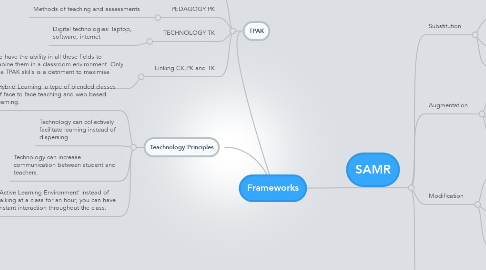
1. TPAK
1.1. CONTENT CK
1.1.1. Subject matter including theories and frameworks
1.2. PEDAGOGY PK
1.2.1. Methods of teaching and assessments
1.3. TECHNOLOGY TK
1.3.1. Digital technologies: laptop, software, internet
1.4. Linking CK,PK and TK
1.4.1. Teachers need to have the ability in all these fields to successfully combine them in a classroom environment. Only having two of the TPAK skills is a detriment to maximise learning.
2. Teachnology Principles
2.1. 'Hybrid Learning' a type of blended classes of face to face teaching and web based learning.
2.2. Technology can collectively facilitate learning instead of dispersing.
2.3. Technology can increase communication between student and teachers.
2.4. 'Active Learning Environment' instead of talking at a class for an hour, you can have instant interaction throughout the class.
3. SAMR
3.1. Substitution
3.1.1. Definition: Computers only replacing manual task of the past with the same results.
3.1.2. Example: Students type out a page and print.
3.1.3. No functional change
3.2. Augmentation
3.2.1. Definition: Technology offers a more efficient tool to perform a task
3.2.2. Example: Students take a test in a online environment.
3.2.3. Minor functional changes, instant feedback
3.3. Modification
3.3.1. Definition: Transformation of the classroom, common tasks are now been done through technology.
3.3.2. Example: Students write a paper and include the usage of media.
3.3.3. Significant functional change, allowance for sound and video in presentations.
3.4. Redefintion
3.4.1. Definition: Technology allows for new tasks which could not be done before.
3.4.2. Example: Students create a video and can work at the same time at home on the video through sharing software on their internet.
3.4.3. Functionally at this point the technology is crucial in creating projects beyond the traditional scope of the classroom.
